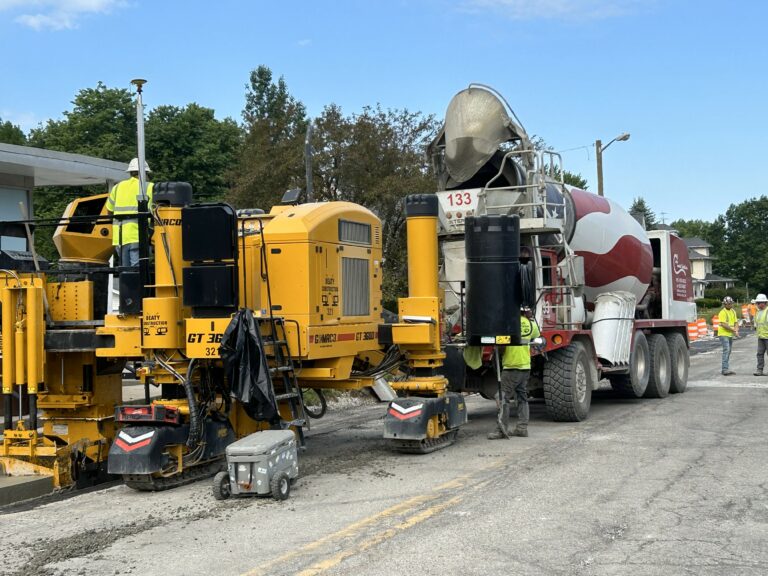
Concrete curbs play a crucial role in defining the edges of roads, parking lots, and pathways, providing structural integrity, aesthetic appeal, and functionality. At Cash Concrete, we understand the importance of choosing the right curbing method for your project. This blog post explores the differences between slip form curbs and traditional curbs, highlighting their respective advantages, processes, and ideal applications.
Understanding Slip Form Curbs
What are Slip Form Curbs?
Slip form curbing is a method where concrete is continuously poured into a moving form. A slip form machine extrudes the concrete into the desired shape as it moves along the planned path, creating a seamless curb.
Advantages of Slip Form Curbs
- Efficiency and Speed: Slip form curbing is significantly faster than traditional methods. The continuous pouring process reduces the time required to complete large stretches of curbing.
- Consistency and Quality: The slip form machine ensures uniformity and precision, resulting in consistent curb shapes and dimensions.
- Cost-Effectiveness: The reduced labor and time required make slip form curbing a more cost-effective solution for large-scale projects.
The Slip Form Curbing Process
- Site Preparation: The path for the curb is prepared and graded.
- Concrete Mixing: A consistent, low-slump concrete mix is prepared.
- Pouring and Shaping: The concrete is poured into the slip form machine, which extrudes it into the desired curb shape.
- Finishing Touches: Smoothing and texturing are applied as needed.
- Curing: Proper curing ensures the concrete reaches its maximum strength and durability.
Understanding Traditional Curbs
What are Traditional Curbs?
Traditional curbing, often referred to as hand-formed or cast-in-place curbing, involves constructing curbs using stationary forms into which concrete is poured. This method is labor-intensive and requires more time than slip forming.
Advantages of Traditional Curbs
- Flexibility in Design: Traditional curbing allows for more intricate designs and shapes, making it suitable for custom or complex curb requirements.
- Control and Precision: Workers have direct control over the concrete placement and finishing, allowing for detailed craftsmanship.
- Suitability for Smaller Projects: For smaller projects or areas with limited access, traditional curbing can be more practical.
The Traditional Curbing Process
- Site Preparation: Excavate and grade the area where the curb will be placed.
- Setting Up Formwork: Install stationary forms to define the shape and dimensions of the curb.
- Concrete Mixing: Prepare the concrete mix according to project specifications.
- Pouring Concrete: Pour the concrete into the forms, ensuring even distribution.
- Finishing the Surface: Smooth and texture the concrete as needed.
- Curing: Allow the concrete to cure properly to achieve strength and durability.
- Removing Forms: Once cured, remove the forms and perform any necessary touch-ups.
Comparing Slip Form Curbs and Traditional Curbs
Efficiency and Speed
- Slip Form Curbs: Faster installation due to the continuous pouring process. Ideal for large-scale projects like highways and long stretches of roads.
- Traditional Curbs: Slower due to the manual setup and pouring process. Better suited for smaller projects or areas requiring detailed work.
Consistency and Quality
- Slip Form Curbs: High consistency and uniformity thanks to machine precision.
- Traditional Curbs: Potential for more variability, but offers detailed craftsmanship and customization.
Cost-Effectiveness
- Slip Form Curbs: Generally more cost-effective for large projects due to reduced labor and time.
- Traditional Curbs: Can be more expensive due to higher labor costs and longer project timelines, but may be more cost-effective for smaller or custom projects.
Design Flexibility
- Slip Form Curbs: Limited to standard shapes and designs dictated by the machine.
- Traditional Curbs: Greater flexibility in design and shape, allowing for customization and intricate detailing.
Choosing the Right Method for Your Project
When deciding between slip form curbs and traditional curbs, consider the following factors:
- Project Size: For large-scale projects, slip form curbing offers efficiency and cost savings. For smaller, detailed projects, traditional curbing may be more appropriate.
- Design Requirements: If your project requires intricate or custom designs, traditional curbing provides the flexibility needed.
- Budget and Timeline: Slip form curbing can reduce costs and timelines for extensive projects, while traditional curbing may be more suitable for projects with specific design or quality requirements.
Conclusion
Both slip form curbs and traditional curbs have their unique advantages and ideal applications. At Cash Concrete, we specialize in delivering high-quality curbing solutions tailored to your project’s needs. Whether you require the efficiency of slip form curbing or the customizability of traditional curbing, our team of experts is here to ensure exceptional results.
